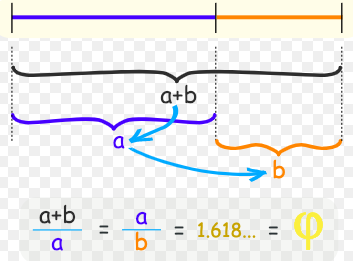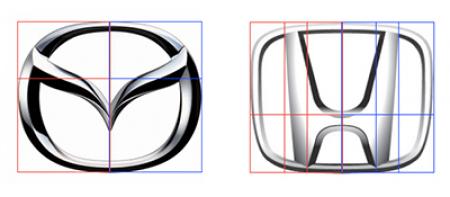Leonardo Pisano, posthumously known as Fibonacci (“son of Bonacci”) discovered a sequence that converges on phi. The rule for his sequence is simple: each element is equal to the sum of the two previous elements, with the first two elements both equal to 1. A sample of the Fibonacci sequence looks like this:
1 1 2 3 5 8 13 21
The pattern was first published in Fibonacci’s book Liber Abaci (“The Book of Calculation”) in 1202. Each number is approximately phi times larger than the previous, where phi = 1.618… Thus, you can solve for any element in the series by using one of two equations:
fn = phin/51/2
fn = phin/(phi + 2)
 The golden ratio is considered to represent the proportions most pleasing to the human eye.
The golden ratio is considered to represent the proportions most pleasing to the human eye.
The first equation assumes that 0 in the sequence corresponds to n = 0, whereas the second assumes that 0 corresponds to n=1. Both of these will round to the correct number. The Fibonacci sequence occurs often in natural patterns, such as those of pinecones, tree branches, rose petals, and mollusk shells.
The representation of phi in Fibonacci’s sequence holds great significance. Phi is considered to be the most irrational of all the irrational numbers (think continued fractions), and is equal to the golden ratio. Also called the divine proportion, the value of phi represents the proportion of shapes that is most pleasing to the human eye—research has found that human eyes scan an image the fastest when the image is shaped according to the golden ratio.
One basic way to achieve this ratio is to break a length into two unequal sections such that the ratio of the longer to the shorter is the same as that of the whole to the longer. For example, breaking 10 into roughly 6.18 and 3.82. 10/6.18 ~= 1.618 and 6.18/3.82 ~= 1.618.
“Golden” shapes appear often in design and composition. Da Vinci used the golden ratio to proportion the Mona Lisa. Michelangelo used it in sections of the Sistine Chapel ceiling. The dimensions of the Great Pyramid follow it. Even today, you can find buildings, photos, and other artwork that are composed according to the golden ratio. Car manufacturers often use the golden ratio in the design of their car’s badge so that the badge’s appearance is more aesthetically pleasing to the consumer.
Engineering is not an isolated profession; the work of any engineer is going to impact some facet of society, for better or worse. The design aspect of engineering can be considered both a science and an art form, a blending of utility and aesthetics. A design intended for public reception should be able to make appeals to logos, ethos, and pathos—to be based in logic, uphold societal ethics, and evoke emotion. For the emotional aspect, a tool like the golden ratio is useful to keep in the arsenal.
 Golden rectangles were used to proportion Honda and Mazda's most recent badges.
Golden rectangles were used to proportion Honda and Mazda's most recent badges.
See original post at Taylor Tucker's blog: https://mechse.illinois.edu/news/blogs/taylor-made-divine-design